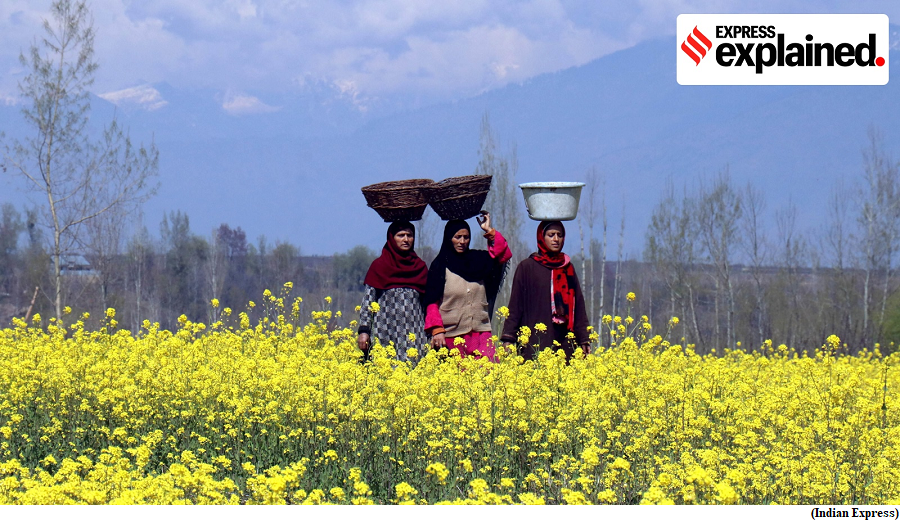How GM mustard was developed, why the question of its approval has now reached Supreme Court (GS Paper 2, Judiciary)

Why in news?
- The Supreme Court recently questioned the Centre on why reports of the court-appointed Technical Experts Committee (TEC) on the biosafety of genetically modified (GM) crops were not looked into by the Genetic Engineering Appraisal Committee (GEAC).
Details:
- The GEAC functions under the Ministry of Environment, Forest and Climate Change (MoEF&CC) and has been tasked with the appraisal of proposals relating to the “release” of GM organisms and products (ordinarily considered hazardous) into the environment.
- A bench of Justices asked Attorney General R Venkataramani whether the GEAC considered the TEC reports before the October 25, 2022 decision to approve the environmental release of transgenic mustard hybrid DMH-11.
Why is the SC examining the matter of GM crops?
- The SC is hearing separate pleas by an activist and an NGO for a moratorium on the release of any genetically modified organisms (GMOs) into the environment.
- The petitions contend that the release must happen only after a comprehensive, transparent and rigorous biosafety protocol is in the public domain, conducted by agencies of independent expert bodies, with its results being made public.
- The Centre is also seeking withdrawal of an oral undertaking given in November 2022 by its law officer about not pressing ahead with commercial cultivation of GM mustard.
- In November, 2022, the SC ordered for status quo on the GEAC’s previous decision to approve GM mustard for commercial cultivation, raising concerns about the risk factors.
- In October 2022, the GEAC had recommended the “environmental release” of the transgenic hybrid mustard DMH-11 for seed production and conducting field demonstration studies on its effects, if any, on honey bees and other pollinating insects.
What is the mustard hybrid DMH-11?
- The transgenic mustard hybrid DMH-11 has been developed by the Centre for Genetic Manipulation of Crop Plants (CGMCP) at Delhi University.
- Hybridisation involves crossing two genetically dissimilar plant varieties that can even be from the same species. The first-generation (F1) offspring from such crosses tend to have higher yields than what either parent can individually give.
- Such hybridisation isn’t easy in mustard, as its flowers have both female (pistil) and male (stamen) reproductive organs, making the plants largely self-pollinating.
- Since the eggs of one plant cannot be fertilised by the pollen grains from another, it limits the scope for developing hybrids, unlike in cotton, maize or tomato, where this can be done through simple emasculation or physical removal of anthers.
How was hybridisation achieved in mustard?
- By genetic modification (GM). Scientists at Delhi University’s Centre for Genetic Manipulation of Crop Plants (CGMCP) have developed the hybrid mustard DMH-11 containing two alien genes isolated from a soil bacterium called Bacillus amyloliquefaciens.
- The first gene (‘barnase’) codes for a protein that impairs pollen production and renders the plant into which it is incorporated male-sterile. This plant is then crossed with a fertile parental line containing, in turn, the second ‘barstar’ gene that blocks the action of the barnase gene.
- The resultant F1 progeny is both high-yielding and also capable of producing seed/ grain, thanks to the barstar gene in the second fertile line.
- The CGMCP scientists have deployed the barnase-barstar GM technology to create what they say is a robust and viable hybridisation system in mustard.
- This system was used to develop DMH-11 by crossing a popular Indian mustard variety ‘Varuna’ (the barnase line) with an East European ‘Early Heera-2’ mutant (barstar).
- DMH-11 is claimed to have shown an average 28% yield increase over Varuna in contained field trials carried out by the Indian Council of Agricultural Research (ICAR).
What was the GEAC’s response in 2022?
- It recommended the environmental release of DMH-11 “for its seed production and testing…prior to commercial release”. It has given the green signal for commercial cultivation by farmers, with the production of seed material being the first step.
- GEAC has also recommended the environmental release of DMH-11’s parental lines (carrying the barnase and barstar genes) for them to be used to develop new hybrids. Such hybrids could give even higher yields than DHM-11.
- Mustard varieties in India have a narrow genetic base. The barnase-barstar system enables breeding of hybrids from a wider range of mustards, including those of East European origin such as ‘Heera’ and ‘Donskaja’.
Why did it take so long for GEAC to clear?
- There has been opposition to GM crops in general, from assorted green groups and the RSS-affiliate Swadeshi Jagran Manch. In GM mustard, there have been two specific concerns voiced as well.
Bar gene:
- The first is the presence of a third ‘bar’ gene, which makes GM mustard plants tolerant to the spraying of glufosinate ammonium, a chemical used for killing weeds.
- This, the opponents allege, will cause displacement of manual labour engaged in weeding by promoting the use of chemical herbicides.
- The DMH-11 developers, however, say that the bar is only a marker gene. It is used to identify those plants that have been genetically modified, the non-GM ones cannot withstand the application of the herbicide and are necessary for large-scale seed production.
Threat to pollinator insects:
- The second concern is over GM mustard threatening or undermining the population of honey bees. Mustard flowers are a source of nectar for honey bees and many other pollinator insects.
Economic aspect:
- One compelling motive for the acceptance of GEAC recommendations could have been India’s spiralling edible oil import bill.
- The country produces only 8.5-9 million tonnes (mt) of edible oil annually, while importing 14-14.5 mt which entailed a record foreign exchange outgo of $18.99 billion in the fiscal year ended March 31, 2022.


